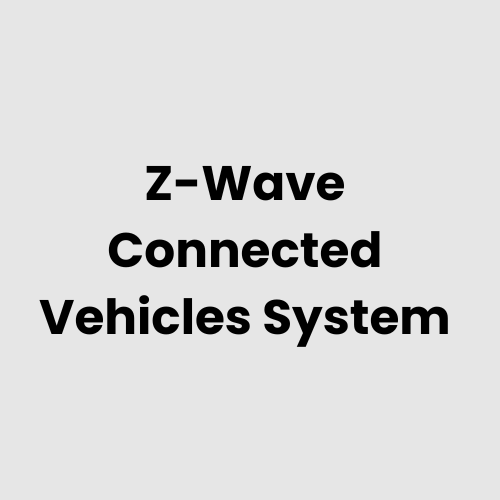Description
Technical Architecture of z-wave Enabled Connected Vehicles System
The technical architecture of z-wave Enabled Connected Vehicles system features an IoT framework designed to interconnect vehicle subsystems for seamless communication. The architecture integrates:
- Sensor Networks: Detecting environmental data, vehicle dynamics, and real-time diagnostics.
- Z-wave Controllers: Acting as the central hub for data aggregation and communication.
- Actuators: Responding to commands for system adjustments such as climate control or lighting.
- Wireless Connectivity: z-wave modules ensure reliable, low-latency communication between in-vehicle systems and external networks.
- Edge Computing: Processes critical data locally to minimize latency, ensuring quick responses for safety-critical functions.
- Cloud Integration: For advanced analytics, predictive maintenance, and remote monitoring.
Hardware Components of z-wave Enabled Connected Vehicles System
- z-wave Central Hub
- Smart Sensors: Environmental, proximity, and diagnostic sensors.
- Actuators: For control of vehicle functions such as locks and windows.
- Vehicle Gateway: Manages data flow between the z-wave network and external systems.
- Display Units: Dash-mounted screens for driver alerts and system interactions.
- Data Storage Devices: Embedded systems for local data logging.
- Communication Modules: For cloud and server connectivity.
- Battery Backup Units: Ensuring uninterrupted operations.
Physical Placement Considerations
• Central Hub: Installed in a secure and easily accessible location within the vehicle dashboard.
• Sensors: Distributed across the vehicle for comprehensive coverage; e.g., proximity sensors near bumpers, environmental sensors on the roof, and diagnostic sensors in the engine bay.
• Actuators: Located at functional points such as door locks, windows, or HVAC systems.
• Display Units: Positioned for optimal driver visibility without obstructing the road view.
• Communication Modules: Mounted where signal interference is minimized, often within the roof or rear sections.
Hardware Architecture of z-wave Enabled Connected Vehicles System
The hardware architecture combines modular components into a robust network. Key elements include:
• Master Control Unit: The hub managing all z-wave communications.
• Peripheral Nodes: Each sensor or actuator acts as a node communicating with the hub.
• Redundant Power Supply: Ensures system reliability during power fluctuations.
• In-Vehicle Network: A mesh network formed by z-wave-enabled devices to ensure comprehensive communication and redundancy.
Deployment Considerations
• Interference Management: Minimize overlap with other wireless systems to maintain z-wave signal integrity.
• Power Efficiency: Employ energy-optimized modules to extend vehicle battery life.
• Firmware Updates: Ensure systems support over-the-air (OTA) updates for continuous improvement.
• Scalability: Design the architecture to support future integration of additional devices or sensors.
• Regulatory Compliance: Adhere to automotive and wireless communication standards for safety and functionality.
List of Relevant Industry Standards and Regulations
- ISO 26262
- SAE J3016
- IEEE 802.15.4
- FCC Part 15
- GDPR (for data privacy compliance)
- AEC-Q100
- UL 4600
Local Server Version
A local server setup ensures data processing and storage within the vehicle or a dedicated nearby server. This configuration:
- Reduces dependency on external networks.
- Ensures high security for sensitive data.
- Provides real-time analytics for time-critical applications.
Cloud Integration and Data Management
Cloud integration enables advanced data handling for z-wave Enabled Connected Vehicles by:
- Real-Time Monitoring: Fleet managers can monitor vehicle diagnostics and location remotely.
- Predictive Maintenance: Using cloud-based AI to analyze usage patterns and predict potential issues.
- Data Security: Robust encryption protocols to secure data in transit and storage.
- Analytics Dashboards: Offering insights into performance, fuel efficiency, and operational trends.
GAO Tek’s expertise ensures seamless deployment of these solutions, leveraging decades of innovation and stringent quality assurance to meet the complex needs of connected vehicle systems.
GAO Case Studies
USA
- Austin, TX
A logistics company in Austin deployed z-wave-enabled connected vehicles to enhance fleet tracking and optimize delivery routes. Using real-time diagnostics, the system reduced maintenance downtime by 30%. GAO Tek’s expertise ensured seamless installation and remote support for continuous operations. - San Francisco, CA
In San Francisco, a ridesharing company integrated z-wave technology into its fleet to monitor vehicle performance and passenger safety. The deployment improved response times for critical issues through predictive maintenance. - New York City, NY
A public transportation project in NYC used z-wave-enabled systems to monitor bus locations and driver behavior. The implementation led to increased operational efficiency and reduced fuel consumption. - Chicago, IL
Chicago’s municipal fleet upgraded to z-wave-enabled connected vehicle systems to enhance route optimization and compliance monitoring. GAO Tek provided robust training and remote support, ensuring consistent performance. - Miami, FL
In Miami, a private courier service adopted z-wave solutions to monitor temperature-sensitive deliveries. Real-time alerts minimized spoilage, boosting customer satisfaction and reducing losses. - Los Angeles, CA
An electric vehicle manufacturer in Los Angeles integrated z-wave technology to manage in-vehicle sensors and automate software updates. The system enhanced safety and reliability for end-users. - Dallas, TX
A construction company in Dallas implemented z-wave-enabled vehicle systems to monitor fuel usage and engine performance across its fleet. GAO Tek’s remote support ensured optimal uptime. - Seattle, WA
A delivery service in Seattle introduced z-wave technology to improve route scheduling and vehicle diagnostics. Enhanced analytics reduced fleet operation costs by 25%. - Boston, MA
In Boston, a university research team incorporated z-wave technology into autonomous vehicles for data collection and environment mapping. The system facilitated seamless communication between test units and control centers. - Denver, CO
A mining company in Denver integrated z-wave-enabled systems to monitor heavy machinery on-site. GAO Tek ensured the solution met safety standards while improving operational efficiency. - Phoenix, AZ
A ride-hailing service in Phoenix utilized z-wave systems for passenger tracking and fleet management. The solution increased vehicle availability and customer satisfaction rates. - Detroit, MI
In Detroit, a car rental agency deployed z-wave technology to track vehicle availability and maintenance schedules, enhancing fleet utilization by 40%. - Atlanta, GA
Atlanta’s municipal garbage collection vehicles adopted z-wave systems for route tracking and vehicle diagnostics. GAO Tek’s support improved operational transparency and reduced fuel costs. - Houston, TX
An oil and gas company in Houston implemented z-wave-enabled monitoring in its service vehicles to track mileage and driver behaviour. This reduced operational inefficiencies and accidents. - Las Vegas, NV
A tourism operator in Las Vegas leveraged z-wave solutions to enhance vehicle scheduling and ensure seamless service for event transportation. The deployment improved uptime and customer satisfaction.
Canada
- Toronto, ON
In Toronto, a logistics company adopted z-wave-enabled connected vehicles to streamline cross-border freight operations. GAO Tek provided localized support and ensured compliance with Canadian regulations. - Vancouver, BC
Vancouver’s public transportation fleet integrated z-wave technology to monitor environmental sensors and fuel efficiency. The system achieved a 20% reduction in greenhouse gas emissions.
GAO Tek Inc. offers comprehensive support and expertise for deploying advanced z-wave solutions, ensuring reliability, compliance, and enhanced performance across connected vehicle systems.
Navigation Menu for Z-Wave
- Z- Wave Gateways/Hubs
- Z-Wave End Devices
- Z-Wave-Cloud, Server, PC& Mobile System
- Z-Wave Accessories
- Z-Wave Resources
Navigation Menu for IoT
- LORAWAN
- ZIGBEE
- Wi-Fi HaLow
- Z-WAVE
- BLE & RFID
- NB-IOT
- CELLULAR IOT
- GPS IOT
- IOT SENSORS
- EDGE COMPUTING
- IOT SYSTEMS
Our products are in stock and can be shipped anywhere in the continental U.S. or Canada from our local warehouse. For any further information, please fill out this form or email us.
We are actively looking for partners who are like us located in the U.S. and Canada. For more information on partnering with GAO, please visit Partner with GAO Tek Inc.. It lists various ways to partner with GAO, such as OEM Partnerships, Technology Integration, Distribution and Reselling Opportunities, Presenting at the Leading Event Tek Summit, Joint R&D Projects, Training and Consulting Services, Industry-Specific Collaborations, Research and Academic Partnerships.



